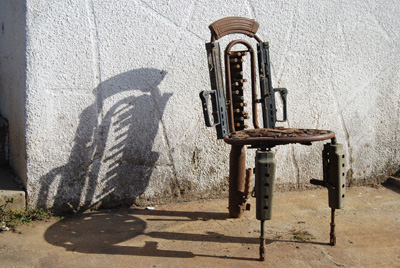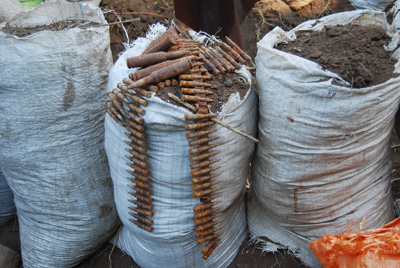
JUAN MICHEL reports…
Seventeen years after the war ended in Mozambique, churches are still collecting and destroying weapons, cleaning up areas of unexploded bombs and shells so the land can be farmed.
When armed conflicts end, the world’s attention tends to fade away quickly say those who have endured the violence. In addition, reconstruction can take a long time. Churches in Mozambique know this all too well, as they told a World Council of Churches team that travelled to the southern African nation on behalf of a project that promotes peace.

“SWORDS INTO PLOUGHSHARES”; Sometimes the weapons collected within the Transforming Guns into Hoes programme are not just destroyed, but become raw material for art works. This aspect of the programme has involved several artists over the past years. PICTURE: Juan Michel/WCC
“This program was the answer to the question, ‘What do we do with the guns?’ that many people asked within the framework of the churches’ post-war work on dialogue, civic education and reconciliation.”
– Rev Dinis Matsolo, general secretary of the Christian Council of Mozambique
It was a Saturday morning when the three-member team made up of church representatives from Portugal, Switzerland and Brazil left Maputo for the community of Chinhangwanine, in Malengani, a rural area some 90 kilometres north-west of the national capital. There, they witnessed a peace project known as Transforming Guns into Hoes (TAE), which is a program of the Christian Council of Mozambique.
A farmer in Chinhangwanine recently discovered an unexploded bomb, dropped from an aircraft many years ago, lying half-buried in land he intended to cultivate. TAE took the device plus guns and ammunition collected in the area, and destroyed them in a controlled explosion.
TAE (the acronym of its name in Portuguese: Transformaçaõ de Armas en Enxadas) is a church-run project begun in 1995, three years after the signing of a peace agreement that ended a 17-year-long civil war. The programme’s name is inspired by the vision of the Hebrew prophet Micah: “They shall beat their swords into ploughshares, and their spears into pruning hooks” (Micah 4:3).
Shortly after its independence from Portugal in 1975, Mozambique entered into a bitter civil war, partly due to its involvement in the struggle against white minority rule in neighbouring South Africa and Rhodesia (today’s Zimbabwe). Both parties in the civil war committed atrocities that did not spare the civilian population until a peace agreement was reached in 1992. By then, war and famine had killed up to a million people.
Today, economic growth in the country is fast, although poverty is widespread with more than half of the population of 22 million living on less than one U.S. dollar a day. Between 2000 and 2002 successive floods and a severe drought hit the country.
TAE aims to answer a question that has persisted in a country that is still awash with weapons after so many years of war. “This program was the answer to the question, ‘What do we do with the guns?’ that many people asked within the framework of the churches’ post-war work on dialogue, civic education and reconciliation,” said the Rev Dinis Matsolo, general secretary of the Christian Council of Mozambique.
Staff from TAE collect weapons from communities that hand them over, and in exchange the communities receive non-monetary goods: tools, sewing machines, bicycles and the occasional tractor, when the number of weapons is significant. The program is funded by development and cooperation agencies from abroad such as Diakonia from Sweden, and the Ehime Global Network in Japan.
Armando Chauque, a member of the Apostolic Faith Church and leader of the Chinhangwanine community in Mozambique, told the WCC team, called ‘Living Letters’, that they were receiving some construction materials to build badly needed classrooms for the local school.
“It is a struggle to convince people to hand over weapons”, said TAE staff member Luis Nicolau, who has worked with the programme for seven years. The main obstacle, Nicolau said, was a shortage of goods to be given as an incentive. “Without them people tend not to collaborate.”
According to Nicolau, in 2008 TAE collected around 18,000 weapons and explosive devices. Since the beginning of its activities, the programme has collected and destroyed well over 700,000 weapons and other implements of war.
According to one estimate, during nearly three decades of violence, including over a decade of fighting for independence, followed by 17 years of civil war, around 10 million firearms fell into the hands of Mozambicans. After the signing of the 1992 peace agreement, there was little trust between the parties to the conflict. Many weapons were therefore not given in but buried and hidden.

BURIED PAST: According to one estimate, some 10 million firearms were put in the hands of Mozambicans during nearly three decades of war. After the signature of the 1992 peace agreement, many weapons were not handed over but rather buried and hidden. PICTURE: Juan Michel/WCC
Only once trust was progressively built up, aided by the churches’ reconciliation work, did people feel confident enough to hand over their weapons or reveal where there were hidden. Still, over time, the locations of many of the guns became lost, for instance when the only people who knew about them died. Today, hiding-places are still being discovered.
“Ours was an atypical war”, said Boaventura Zita, coordinator of the TAE programme. “Even after the peace agreement was reached, the rebels did not trust the government, so they hid their weapons because they foresaw the possibility of a new fight. The whereabouts of many of those weapons are still unknown.”
In tracking them down, TAE’s 27 staff cover the whole country. The destruction of collected armaments is done either by “cutting” them up at the TAE premises or by blowing them up with dynamite.
Specialised technicians provided by the state security forces do this work. According to the contract between the government and the church council, the technicians are not allowed to intervene in the negotiations with the communities or to interrogate people who hand over guns.
Sometimes, collected weapons are not just destroyed but go on to become the raw material for art works. The WCC team met Cristovao “Kester” Estevao, who is working on a peace monument on the Maputo Bay waterfront. The work features a huge earth globe and a dove fully made of former firearm parts.
“TAE is a programme focused on transformation,” stressed Rev Matsolo, who explained that this is the reason why the project did not buy weapons for money but instead offered tools as an incentive. “As peace is not an individual issue, the communities need to be involved, therefore the goods given in exchange can be used collectively,” he explained. “The aim is to mobilise and sensitise communities for a culture of peace.”
This is an edited version of a story written for the World Council of Churches by Juan Michel, WCC media relations officer.





